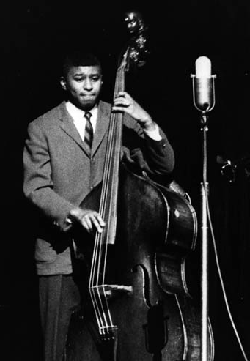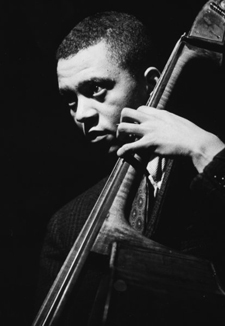Paul Chambers
 Paul Laurence Dunbar Chambers, Jr. was born April 22, 1935, in Pittsburgh, P.A. and died January 4, 1969, in New York, N.Y. He was the son of Paul Laurence Chambers and Ann Dunbar and had two children named Renee and Eric.
Paul Laurence Dunbar Chambers, Jr. was born April 22, 1935, in Pittsburgh, P.A. and died January 4, 1969, in New York, N.Y. He was the son of Paul Laurence Chambers and Ann Dunbar and had two children named Renee and Eric.
Upon winning Down Beat magazine’s 1956 “New Star Award,” jazz bassist Paul Chambers entered the national spotlight as one of the finest young talents of the hard bop jazz scene. Best known for his eight-year tenure with Miles Davis, Chambers appeared as a guest recording artist with numerous musicians, including the debut albums of John Coltrane, Kenny Burrell, and Cannonball Adderly. His bass bow style was largely responsible for carrying forth the bowing approach pioneered by Jimmy Blanton, an early bassist with the Duke Ellington Orchestra, and reintroducing the arco or bowed style as a featured technique in the modern jazz idiom.
While attending the Pittsburgh school system, Chambers took up music after one of his instructors selected him to play baritone horn. Following the death of his mother in 1948, Chambers went to live with his father in Detroit, where he switched to tuba and eventually pursued the study of the double bass. By 1952, he was receiving private lessons from a bassist in the Detroit Symphony Orchestra and, while attending Cass Technical High School, played in the school’s symphony orchestra. During this time, Chambers’ formal symphonic training coincided with a strong interest in bebop jazz. “I started to listen to Charlie Parker and Bud Powell at age fifteen,” recalled Chambers in Down Beat. “At first I played along with records and I used to try to pick out some of the things Parker…would do.” As jazz critic Leonard Feather pointed out in the liner notes to the album Whim of Chambers, “Oscar Pettiford and Ray Brown, the first bassists [Chambers] admired, were followed in his book by Percy Heath, Milt Hinton and Wendell Marshall for their rhythm section work, Charles Mingus and George Duvivier for their technical powers and their efforts in broadening the scope of jazz bass. [Jimmy] Blanton, of course, is his all-time favorite.”
In 1955, Chambers went on tour with saxophonist Paul “Vice Pres” Quinchette. After his stint with Quinchette, he moved to New York and joined a group led by trombonists J.J. Johnson and Kai Winding. He then worked with pianist Benny Green’s combo and George Wallington’s group at Greenwich Village’s Cafe Bohemia–a unit comprised of saxophonist Jackie McLean, trumpeter Donald Byrd, and drummer Art Taylor. Soon after, McLean brought Chambers to the attention of Miles Davis, who was seeking a bassist for his quintet. “Everybody was raving about Paul,” recalled Davis in his memoir Miles.
By September of 1955, Rollins left Davis’ quintet and was replaced by Philadelphia-born saxophonist John Coltrane. In October of the same year, the newly formed quintet made their first recordings for Columbia while Miles was still under contract with Prestige. The group’s first issued album, recorded in November of 1955, emerged as a set of fine ballads entitled Miles. In his original review of the album, Nat Hentoff, as quoted in the book Milestones I, stated that Chambers “lays down a rhythm that could carry an army band.” The quintet subsequently recorded two 1956 sessions for Prestige which produced the albums Cookin’ and Relaxin’. In describing the former album in Hard Bop, David Rosenthal wrote, “Garland, Chambers, and Jones comprised one of the most cohesive rhythm sections in the history of jazz, a trio closely attuned to each other and to Davis and Coltrane.”
In March of 1958, Chambers and drummer Jimmy Cobb, along with pianist Tommy Flanagan, made up the rhythm section for the album Kenny Burrell and John Coltrane. Included on the album is Flanagan’s number Big Paul dedicated to Chambers. “Paul Chambers’ walking introduction to the tune,” observed Joe Goldberg in the album’s liner notes, “brings back an entire era. Flanagan and Cobb slip easily under him, as if they have all the time in the world.” After Philly Joe Jones left Davis’ band in May 1958, Cobb joined Davis’s quintet. In July and August of 1958, Davis and arranger Gil Evans brought in Chambers and tubaist Bill Barber to provide the low-end accompaniment for his orchestral jazz album Porgy and Bess. On the numbers The Buzzard Song and Bess, You Is My Woman Now, observed Barry Kernfield in The Blackwell Guide to Recorded Jazz, Chambers and Barber “are paired together, but not as bass instruments; instead they play a jumpy low-pitched melody” intended to blend with Evans’ score for the brass and woodwinds sections.
In 1960, Chambers continued his path as a studio musician. Within a ten-piece band setting, which included drummer Roy Haynes, he appeared on Oliver Nelson’s acclaimed MCA album Blues and the Abstract Truth. He also appeared on Art Pepper’s Gettin’ It Together and Hank Mobley’s Roll Call and Work Out, which found Chambers in the company of Wynton Kelly, Philly Joe Jones, and guitarist Grant Green.
In 1965, Chambers and drummer Art Blakey backed Hank Mobley for his album The Turnaround. In The Guide to Classic Recorded Jazz, Tom Piazza described the recording as “a strongly swinging set in which Mobley’s toughest edge is brought out.” Two years later, Chambers recorded several albums with saxophonist Sonny Criss and worked with pianist Barry Harris at New York’s West Boondock Club. After years of heavy substance abuse, Chambers died from tuberculosis on January 4, 1969.

